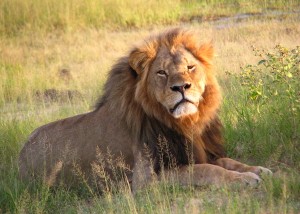
The recent killing of an African lion (”Cecil”) in Zimbabwe by American dentist Walter Palmer is despicable on so many levels. Dr. Palmer lured the lion outside of its legally protective habitat, shot it with a crossbow, and then stalked the maimed and pained lion for 40 hours, until finally gunning it down, skinning and beheading it. The thrill of killing, bodily dismemberment, and the infliction of days of living suffering is sickening, and it so grossly violates the values of our faith.
I would like to spend a few moments delving a bit more precisely into what Judaism has to say about this illegal hunt, as although the hunt greatly offended our sensitivities, it can also serve as the basis to draw out a few important lessons.
Despite the fact that the Torah encourages humans to be productive, to build, to become great, and to harness nature toward these goals (v. Ramban [Nachmanides] on Gen. 1:28), Halacha prohibits the infliction of unnecessary pain upon any creature (“tza’ar ba’alei chayim”). Additionally, Judaism has rejected the propriety of sport hunting, due to the needless cruelty involved. (Please see here.) Furthermore, Ramban explains (on Deut. 22:6) that the Torah’s prohibitions of slaughtering a mother and child animal on the same day and of taking a mother bird when harvesting its eggs or chicks reflects God’s desire to preserve the species of Creation, for permitting the one-shot demise of an animal “family” can threaten the viability of the species. Ramban also writes that these two commandments reflect the Torah’s aversion to cruelty.
These sentiments all strike a direct chord regarding Dr. Palmer’s recent lion hunt and instruct us that it violates the sacred values of the Torah. While Dr. Palmer is not bound by the Torah, the ethos which the Torah adjures us to embrace should make us revolted by his actions.
However, there is an additional point that must be considered. Although every single organism and its components attest to the purposeful work of a Divine Creator, who with unfathomable and inimitable abilities and intelligence designed innumerable and incredibly complex systems to work in tandem for a specific goal, there are certain aspects of nature that simply strike us as so gorgeous and majestic, that their very visage loudly proclaims the handiwork of the Creator. Which creature other than the lion, with its magnificent and statuesque countenance and form, more thrillingly declares that it was fashioned by a Master Creator and is not the product of chance? When one observes the stunning beauty of nature’s “best”, one not only intellectually perceives God, as is the case when examining the orderly and stupefying intricacy of anything organic and of the universe’s systems of operation; rather, one who encounters the most striking components of nature dramatically sees, senses and feels the Hand of God, as manifest in these breathtaking, arresting and stunning creations.
When we encounter the most spectacular elements of nature, we instinctively say “awesome”, as we are awed by an inherent recognition of the Creator, as embodied in this encounter. Yet there is something beyond this – a second, more sublime level.
The Sages of the Talmud tell us that one experiences the Shechinah, the Divine Presence, by engaging in the study of Torah. On the one hand, this means that since the Torah is the Word of God, one who studies Torah directly links firsthand and intimately to God’s very communications to humankind.
There is, I believe, an additional meaning here. Anyone who learns Torah with sincerity is grasped and overcome by the sheer, holy beauty of its ideas and narratives – be they the Biblical stories, such as the magnificently dramatic and wondrous story of Yosef (Joseph) and his brothers, or the spectacularly profound halachic abstractions of the Talmud, which evince intense underlying legal structures that have been purposefully woven, beyond any human ability, into grand and seamless matrices. One is struck by the Torah’s breathtaking spiritual insights and messages and its incredibly deep halachic edifices. The undercurrents that flow throughout the Torah grip and move those who study it with whole hearts, whispering in their ears that they are connected with God.
Let us sense, feel and see the fingerprints of the Shechinah in nature, and hear, encounter and draw near to the Shechinah through Torah. May we be ever stirred to this awareness and awakened to this incredible reality.
The words of this author reflect his/her own opinions and do not necessarily represent the official position of the Orthodox Union.
